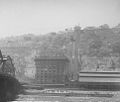Pittsburgh & Lake Erie Railroad Station | |||||||||||||||||||||||||||||||||||||||||||
|---|---|---|---|---|---|---|---|---|---|---|---|---|---|---|---|---|---|---|---|---|---|---|---|---|---|---|---|---|---|---|---|---|---|---|---|---|---|---|---|---|---|---|---|
 Pittsburgh & Lake Erie Railroad Station, April 2007 | |||||||||||||||||||||||||||||||||||||||||||
| General information | |||||||||||||||||||||||||||||||||||||||||||
| Line | Pittsburgh Subdivision | ||||||||||||||||||||||||||||||||||||||||||
| History | |||||||||||||||||||||||||||||||||||||||||||
| Opened | 1898 | ||||||||||||||||||||||||||||||||||||||||||
| Closed | July 12, 1985 | ||||||||||||||||||||||||||||||||||||||||||
| Former services | |||||||||||||||||||||||||||||||||||||||||||
| |||||||||||||||||||||||||||||||||||||||||||
Pittsburgh & Lake Erie Railroad Station | |||||||||||||||||||||||||||||||||||||||||||
| Location | Smithfield St. at Carson St., Pittsburgh, Pennsylvania | ||||||||||||||||||||||||||||||||||||||||||
| Coordinates | 40°26′1″N80°0′14″W / 40.43361°N 80.00389°W | ||||||||||||||||||||||||||||||||||||||||||
| Area | less than one acre | ||||||||||||||||||||||||||||||||||||||||||
| Built | 1898 | ||||||||||||||||||||||||||||||||||||||||||
| Architect | Burns, William George | ||||||||||||||||||||||||||||||||||||||||||
| Architectural style | Classical Revival, Edwardian | ||||||||||||||||||||||||||||||||||||||||||
| NRHP reference No. | 74001743 [1] | ||||||||||||||||||||||||||||||||||||||||||
| Significant dates | |||||||||||||||||||||||||||||||||||||||||||
| Added to NRHP | January 11, 1974 | ||||||||||||||||||||||||||||||||||||||||||
| Designated CPHS | March 15, 1974 [2] | ||||||||||||||||||||||||||||||||||||||||||
| Designated PHLF | 1970 [3] | ||||||||||||||||||||||||||||||||||||||||||
| |||||||||||||||||||||||||||||||||||||||||||
The Pittsburgh & Lake Erie Railroad Station, now Landry's Grand Concourse restaurant in Station Square Plaza in Pittsburgh, Pennsylvania, is an historic building that was erected in 1898. It was listed on the National Register of Historic Places in 1974. [4]









